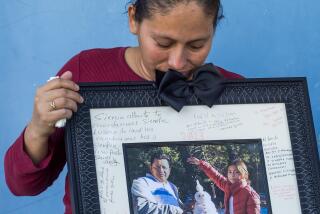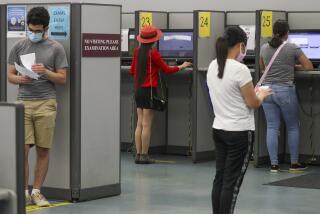Where’s Neighbors’ Outrage Over Repeat Drunk Drivers?
- Share via
Sidney Landau was run out of North County, and James Crummel would be right on his heels if his Newport Beach neighbors had anything to say about it. Police publicly identified both as repeat sex offenders and, for reasons that are understandable if not necessarily rational, some residents want to expel them forever.
Contrast the din surrounding those two ex-cons with the silence that greets other ex-cons who are much more prevalent than child molesters but who, when they choose to prey on the public, can do more lethal damage.
What about drunk drivers who, in their worst moments, can take out entire families? Or, if they don’t kill them, leave them damaged for life?
You’re bored already, aren’t you?
Child molesters make our blood boil. Drunk drivers do not. A child molester seems less than human; a drunk driver is the life of the party who had one too many and didn’t mean to hurt anyone.
As likely as not, says Reidel Post, a drunk driver’s neighbor might even feel an odd sympathy for the perpetrator, falling back on the old chestnut, “There but for the grace of God go I.”
On a typical week, maybe half a dozen people will telephone Mothers Against Drunk Driving in Orange County, where Post is executive director, and complain about a drunk-driving neighbor. Those calls never make the news. It’s almost always one person calling about a particular neighbor, rather than a concerted effort by a group of neighbors. No one ever carries a picket sign outside a repeat offender’s house if the offense is drunk driving.
Recent stories about a Santa Ana man convicted for the 12th time on drunk-driving charges didn’t prompt his neighbors to demand he move. Is that because he hasn’t killed anyone yet, or because we all either know or can imagine what it’s like to be tipsy behind the wheel?
Obviously, a distinction exists between fearing a recidivist molester on the block and a chronic drunk driver. The molester poses a potential threat to children in the immediate vicinity, while the drunk driver is not likely to run over the person who lives next door.
Post understands that but anguishes over the public’s seeming apathy toward the carnage drunks cause. “The thing that bothers me the most is that the drunk driver, even the impaired driver, rationalizes their behavior. Many in the community rationalize the impaired driver’s behavior. Some people within the system that processes these people rationalize the behaviors. And the victims are left devastated, alone and very often misunderstood.”
Misunderstood? “They’re told it was an accident,” Post says. “People tell them, ‘Gosh, I’m sure the person didn’t mean to cause your family harm. They didn’t plan to kill your daughter or permanently injure the breadwinner of the family. Don’t you think it’s time to forget it and get on with living?’
“With drunk driving, there are two choices before committing the crime--one is to drink and the other is to drive. Still, we see the word ‘accident’ attached to it.”
Child molestation is a pervasive national problem, but when it comes to deaths, children are much more at risk from drunk drivers than molesters. In a typical year, between 50 and 150 children are kidnapped and killed, according to the National Center for Missing and Exploited Children. More than 3,100 children were killed in motor vehicle accidents in the most recent statistical year, and since about half of all accidents involve drunk drivers, the alcohol-related deaths would number more than 1,500.
Using statistics compiled by local law enforcement agencies, MADD says that about one-third of alcohol-related arrestees are repeat offenders. It’s common knowledge, Post says, that many repeat offenders continue driving.
Citing the most recent CHP statistics for Orange County, Post says that 53 deaths resulted from alcohol-related traffic collisions in 1995. Another 2,622 people were injured in 1,731 accidents. The good news, she says, is that the fatalities in 1995 were half the total for 1990, suggesting that the public is heeding drunk-driving warnings.
Yet where is the public outrage against drunk drivers? And, especially, the repeat offender?
Part of the problem is the age-old bugaboo about how to punish offenders. Everyone wants to lock up repeat sex offenders, but what about repeat drunks? “Megan’s Law” allows sex offenders to be identified, but even MADD stayed neutral in the short-lived California Legislature debate about creating special license plates for repeat DUI offenders. The proposed bill died a quick death in committee.
“MADD isn’t against drinking,” Post says. “We’re not a prohibitionist group. We’re against ingesting alcohol or other drugs and getting behind the wheel. I tend to live life seeing an awful lot of gray, but when it comes to something as pervasive as this and something as costly to families as well as to the community and employers. . . .
“What other crimes are committed where people can go ahead and keep the weapon of choice and choose to do it again and again and again? I don’t think repeat offenders should have their automobiles. They shouldn’t have their weapon of choice.”
Dana Parsons’ column appears Wednesday, Friday and Sunday. Readers may reach Parsons by writing to him at The Times Orange County Edition, 1375 Sunflower Ave., Costa Mesa, CA 92626, or calling (714) 966-7821.
More to Read
Sign up for Essential California
The most important California stories and recommendations in your inbox every morning.
You may occasionally receive promotional content from the Los Angeles Times.









